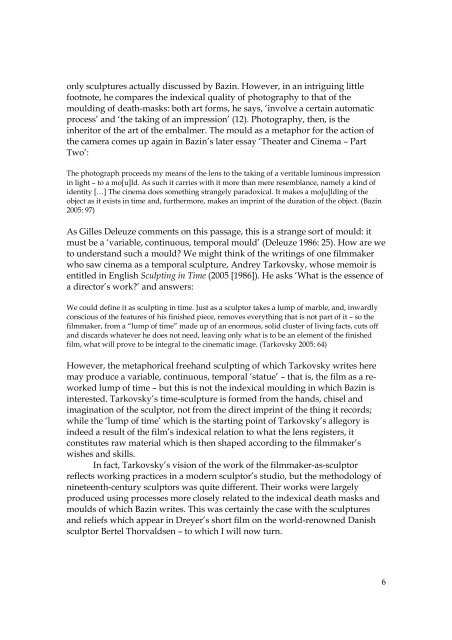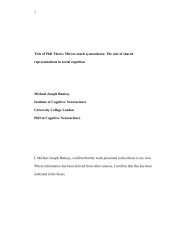A Cinema of Dust: On the Ontology of the Image from Dreyer's ...
A Cinema of Dust: On the Ontology of the Image from Dreyer's ...
A Cinema of Dust: On the Ontology of the Image from Dreyer's ...
You also want an ePaper? Increase the reach of your titles
YUMPU automatically turns print PDFs into web optimized ePapers that Google loves.
only sculptures actually discussed by Bazin. However, in an intriguing little<br />
footnote, he compares <strong>the</strong> indexical quality <strong>of</strong> photography to that <strong>of</strong> <strong>the</strong><br />
moulding <strong>of</strong> death-masks: both art forms, he says, ‘involve a certain automatic<br />
process’ and ‘<strong>the</strong> taking <strong>of</strong> an impression’ (12). Photography, <strong>the</strong>n, is <strong>the</strong><br />
inheritor <strong>of</strong> <strong>the</strong> art <strong>of</strong> <strong>the</strong> embalmer. The mould as a metaphor for <strong>the</strong> action <strong>of</strong><br />
<strong>the</strong> camera comes up again in Bazin’s later essay ‘Theater and <strong>Cinema</strong> – Part<br />
Two’:<br />
The photograph proceeds my means <strong>of</strong> <strong>the</strong> lens to <strong>the</strong> taking <strong>of</strong> a veritable luminous impression<br />
in light – to a mo[u]ld. As such it carries with it more than mere resemblance, namely a kind <strong>of</strong><br />
identity […] The cinema does something strangely paradoxical. It makes a mo[u]lding <strong>of</strong> <strong>the</strong><br />
object as it exists in time and, fur<strong>the</strong>rmore, makes an imprint <strong>of</strong> <strong>the</strong> duration <strong>of</strong> <strong>the</strong> object. (Bazin<br />
2005: 97)<br />
As Gilles Deleuze comments on this passage, this is a strange sort <strong>of</strong> mould: it<br />
must be a ‘variable, continuous, temporal mould’ (Deleuze 1986: 25). How are we<br />
to understand such a mould? We might think <strong>of</strong> <strong>the</strong> writings <strong>of</strong> one filmmaker<br />
who saw cinema as a temporal sculpture, Andrey Tarkovsky, whose memoir is<br />
entitled in English Sculpting in Time (2005 [1986]). He asks ‘What is <strong>the</strong> essence <strong>of</strong><br />
a director’s work?’ and answers:<br />
We could define it as sculpting in time. Just as a sculptor takes a lump <strong>of</strong> marble, and, inwardly<br />
conscious <strong>of</strong> <strong>the</strong> features <strong>of</strong> his finished piece, removes everything that is not part <strong>of</strong> it – so <strong>the</strong><br />
filmmaker, <strong>from</strong> a “lump <strong>of</strong> time” made up <strong>of</strong> an enormous, solid cluster <strong>of</strong> living facts, cuts <strong>of</strong>f<br />
and discards whatever he does not need, leaving only what is to be an element <strong>of</strong> <strong>the</strong> finished<br />
film, what will prove to be integral to <strong>the</strong> cinematic image. (Tarkovsky 2005: 64)<br />
However, <strong>the</strong> metaphorical freehand sculpting <strong>of</strong> which Tarkovsky writes here<br />
may produce a variable, continuous, temporal ‘statue’ – that is, <strong>the</strong> film as a reworked<br />
lump <strong>of</strong> time – but this is not <strong>the</strong> indexical moulding in which Bazin is<br />
interested. Tarkovsky’s time-sculpture is formed <strong>from</strong> <strong>the</strong> hands, chisel and<br />
imagination <strong>of</strong> <strong>the</strong> sculptor, not <strong>from</strong> <strong>the</strong> direct imprint <strong>of</strong> <strong>the</strong> thing it records;<br />
while <strong>the</strong> ‘lump <strong>of</strong> time’ which is <strong>the</strong> starting point <strong>of</strong> Tarkovsky’s allegory is<br />
indeed a result <strong>of</strong> <strong>the</strong> film’s indexical relation to what <strong>the</strong> lens registers, it<br />
constitutes raw material which is <strong>the</strong>n shaped according to <strong>the</strong> filmmaker’s<br />
wishes and skills.<br />
In fact, Tarkovsky’s vision <strong>of</strong> <strong>the</strong> work <strong>of</strong> <strong>the</strong> filmmaker-as-sculptor<br />
reflects working practices in a modern sculptor’s studio, but <strong>the</strong> methodology <strong>of</strong><br />
nineteenth-century sculptors was quite different. Their works were largely<br />
produced using processes more closely related to <strong>the</strong> indexical death masks and<br />
moulds <strong>of</strong> which Bazin writes. This was certainly <strong>the</strong> case with <strong>the</strong> sculptures<br />
and reliefs which appear in Dreyer’s short film on <strong>the</strong> world-renowned Danish<br />
sculptor Bertel Thorvaldsen – to which I will now turn.<br />
6
















